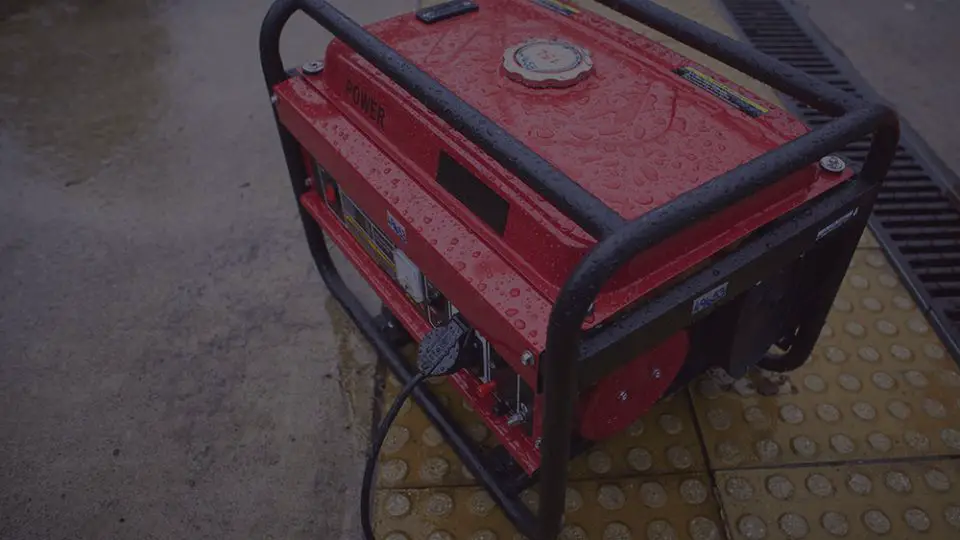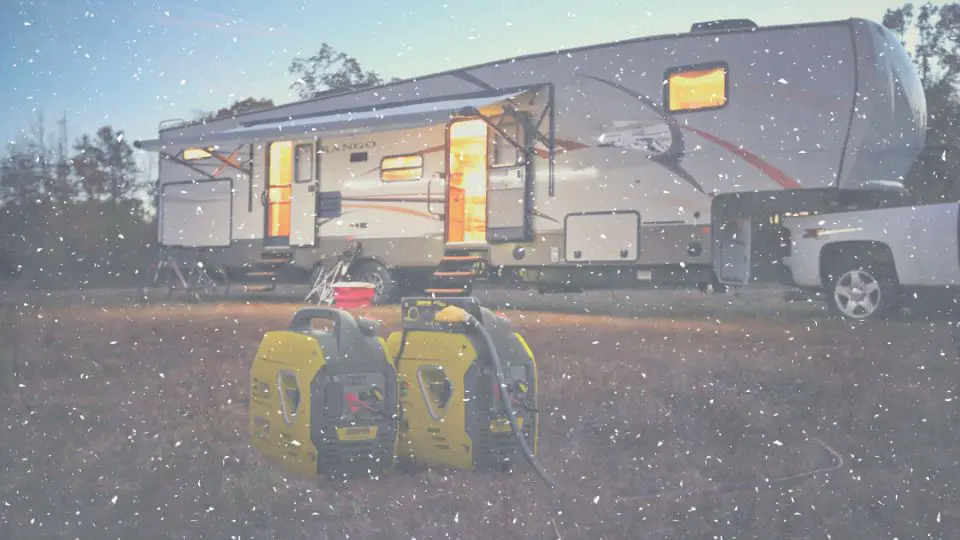This post may contain affiliate links. As an affiliate, we earn from qualifying purchases. We get commissions for purchases made through links in this post.
Portable generators are a popular choice for many people who need backup power during a power outage or for those who need power in remote locations. However, one question that often arises is whether or not portable generators can get wet.
The short answer is no, portable generators must not get wet. Water and electricity are not compatible, so operating a generator in wet conditions without proper protection can cause substantial damage to the device and pose a risk to the user’s safety. The generator’s power outlets should never get wet, and water should be kept away from the control panel and wire connections at all times.
While it may be required to use a generator in rainy weather, it is critical to take precautions to protect the equipment and ensure the user’s safety. In this article, we examine the dangers of running a generator in wet conditions, ways to protect your generator against water, and the best ways to continue running a generator safely and efficiently.
What happens if water gets into a generator?
When water gets into a portable generator, it can cause serious damage to the machine. The power outlets on the generator need to be kept away from rain and snow, as it can lead to a short circuit that can fry the generator’s electrical components.
Water can also cause rust to build on the generator’s metal parts, which can cause further damage and potentially reduce its lifespan. If water passes into the generator’s fuel tank, it will mix with the fuel and cause the engine to break down.
Aside from causing harm to the generator, running a generator in wet conditions might endanger the user. Because water is a good conductor of electricity, there is a risk of electrocution if the generator is wet and there is an active electrical connection.
It is important to note that using a generator during a thunderstorm is not recommended, as it can be dangerous and increase the risk of damage to the equipment.
Carbon monoxide poisoning is also a risk when using a generator indoors or in enclosed spaces, so it is important to always use a generator in a well-ventilated area.
To conclude, water getting into a generator can cause damage to the machine, create danger for the user, and potentially shorten the lifespan of the generator. It is important to always keep the generator dry and avoid using it in wet conditions or during a storm without proper cover.
Can water ruin a generator?
Portable generators are a great source of backup power during emergencies or when you need electricity in remote locations. However, it is important to know that water and generators do not mix well. Water can cause significant damage to a generator and pose a safety hazard to the operator.
When a generator gets wet, it can lead to rust and corrosion on the metal parts, which can cause the generator to malfunction. Water can also damage the fuel system, causing the engine to stall. In addition, the electrical wires and connections can get short-circuited, which will lead to generator failure.
Furthermore, water can penetrate the electrical outlets and control panel of the generator, leading to electrocution hazards for the operator. The generator’s electrical voltage can be a danger to the operator if exposed to moisture. Therefore, it is essential to keep water off the control and connection panel at all costs.
Overall, water can get several adverse effects on the generator itself by triggering rust, damaging its electrical components, etc. It also puts a risk to the user of a wet generator. You must always protect your generator from getting wet. The next section explains how to prevent a generator from getting wet.
How to prevent a generator from getting wet?
When using a portable generator outside, it is crucial to prevent it from getting wet. As you’ve already learned, water can damage the generator and pose a safety hazard for the operator. Here are some ways to protect your generator from rain and other wet conditions:
- Cover the generator: The most straightforward way to protect your generator from the rain is to cover it with a rain cover or a tarp. Make sure the cover is large enough to cover the entire generator, including the power outlets and the control panel. You can also purchase a generator shed or box designed to protect your generator from the elements.
- Use a pop-up canopy or umbrella: Another option is to use a pop-up canopy or an umbrella to keep your generator dry. This option is ideal for those who need to use their generator for an extended period in wet conditions. Make sure the canopy or umbrella is large enough to cover the entire generator.
- Keep the generator in a dry place: If possible, keep your generator in a dry location such as a shed. This option provides the most protection from the elements, but you need to be extra cautious as this may increase the risks of carbon monoxide poisoning or fire.
- Elevate the generator: Elevating your generator off the ground will reduce the chances of it being flooded by puddles. You can use cinder blocks or wooden pallets to raise the generator off the ground. This step is required if you’re running your generator on an uneven surface with pits.
By taking these precautions, you will prevent a generator from getting wet, or at least, will reduce of chances of it getting wet. Remember: Never allow a portable generator to get wet, especially its power outlets. Always keep water off the control and connection panel at all costs.
It is also essential to note that using a generator in wet conditions without proper protection can cause significant damage to your machine. For more information on how to run a generator in the rain, check out this article. If you are looking for a generator rain cover, check out this list of the top 10 generator rain covers.
What to do if the generator gets wet?
If a portable generator gets wet, it can pose a serious risk of electric shock and damage to the generator. It is important to take immediate action to ensure the safety of the user and the longevity of the generator.
Here are some steps to take if the generator gets wet:
- Turn off the generator: The first step is to stop the generator and unplug it from any electrical outlet. This will prevent any electrical shock or damage to the generator.
- Move the generator to a dry location: If possible, move the generator to a dry location. If there is no shed or garage for storage available, try to cover a generator with a tarp or a plastic sheet to protect it from further exposure to water.
- Let it dry: Once the generator is in a dry location, let it sit for at least 24 hours to dry completely. Do not attempt to turn on the generator until it is completely dry.
- Inspect the generator: After the generator has dried, inspect it for any signs of damage. Check the oil and fuel levels to ensure they are not contaminated with water. If there is any damage to the generator, do not attempt to turn it on and contact a professional for repairs.
- Test the generator: Once you have ensured the generator is intact, run a short test to ensure it is working properly. Start the generator and let it run for a few minutes to make sure there are no issues.
It is important to note that prevention is key when it comes to protecting a portable generator from water damage. Always store the generator in a dry location and never use it in wet conditions without proper protection.
Where to put a generator during a storm?
During a storm, it is crucial to keep your portable generator in a safe place. Here are some tips on where to put your generator during a storm:
- Keep the generator at least 6 meters away from the house: It is recommended to keep the generator at least six meters away from the house in a well-ventilated shed. This will prevent carbon monoxide poisoning and ensure that the generator is not damaged by the storm.
- Place the generator on a dry surface: Ensure that the generator is placed on a dry surface and is not sitting in a puddle or a pit. This will prevent any electrical shorts or damage to the generator.
- Use a generator cover: A rain cover can protect the generator from the water and keep it dry. Ensure that the cover is made of waterproof material and fits the generator properly.
- Keep the generator elevated: Elevating the generator can prevent it from being damaged by any flooding or standing water. A raised platform or cinder blocks can be used to elevate the generator.
- Keep the generator away from flammable materials: Ensure that the generator is kept away from any flammable materials such as gasoline, propane, or other chemicals. This will prevent any accidents or fires.
By following these tips, you can ensure that your generator is safe during a storm and can continue to provide power when you need it the most.
Can a generator get wet when not in use?
When a portable generator is not in use, it should be stored in a dry and covered area such as a shed or a garage. Exposure to moisture can result in rust and corrosion, which can damage the generator’s internal components. If the generator’s internal components become corroded, it may not function properly when it is needed.
It is essential to keep the generator dry when not in use. Moisture can also cause damage to the generator’s electrical components, which can be dangerous when the generator is in use. If the generator’s electrical components are damaged due to exposure to moisture, it can cause electrical shock, which can be fatal.
To prevent moisture from damaging the generator when not in use, it is recommended to keep the generator covered with a waterproof cover. A generator cover can protect the generator from rain, snow, and other forms of moisture.
If the generator has been exposed to moisture it is essential to inspect it thoroughly before using it. Check for signs of rust, corrosion, and damage to the electrical components. If there is any damage, it is recommended to have a professional inspect and repair the generator before using it.
A generator should never be allowed to get wet, even when not in use. Moisture can cause damage to the generator’s internal components, which can lead to malfunctioning and even electrical shock. It is recommended to store the generator in a dry and covered area and inspect it thoroughly before using it if it has been exposed to moisture.
Conclusion
In summary, portable generators should not get wet or be used in wet conditions. According to most manufacturers, exposing a generator to moisture can harm the device and endanger surrounding users.
While it may be necessary to use a generator in the rain, it is not worth the risk of damaging the machine or electrocuting oneself. It is recommended to use a generator shelter or cover to protect the device from wet conditions.
Additionally, it is important to keep water off the control and connection panel at all costs. The power outlets on the generator should never get wet, as this can cause significant damage to the machine.
Overall, it is important to follow the manufacturer’s instructions and safety guidelines when using a portable generator. By taking proper precautions and protecting the device from wet conditions, you can ensure the safe and effective operation of a generator.




1 thought on “Can portable generators get wet?”
Comments are closed.